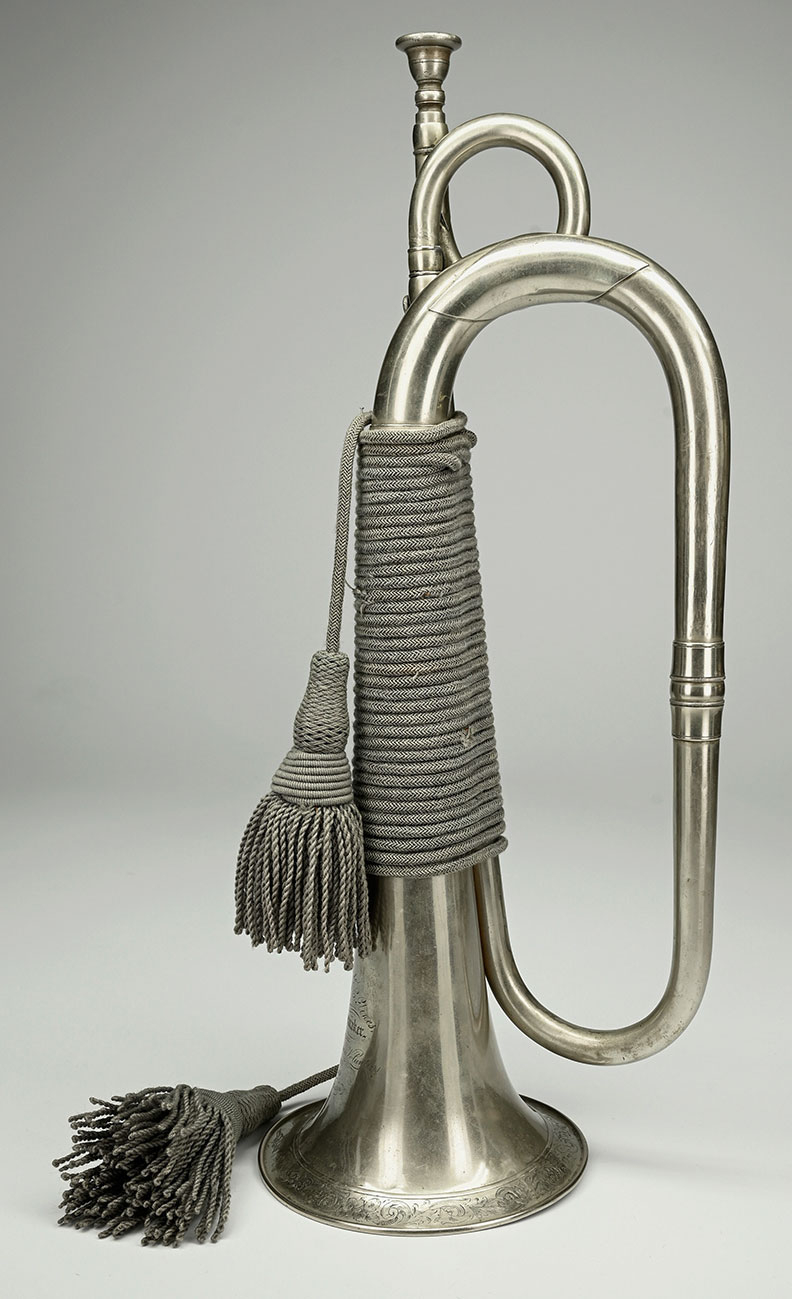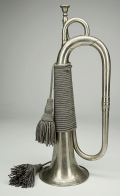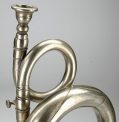site search
online catalog
BEAUTIFUL SILVER PRESENTATION BUGLE 13th MICHIGAN INFANTRY: CHICKAMAUGA, STONES RIVER; 14th CORPS BRIGADE BAND ON THE MARCH TO THE SEA, CAMPAIGN OF THE CAROLINAS

$12,500.00 SOLD
Quantity Available: None
Item Code: 1268-163
This is a beautiful silver bugle with “pig-tail” crook and fully engraved garland, made and marked by well-known Boston maker E.G. Wright and bearing an impressive May 1863 presentation from the Colonel of the 13th Michigan to the leader of his new regimental band, who in turn led it through the Tullahoma and Chickamauga Campaigns, Siege of Chattanooga, pursuit of Forrest in northern Alabama, and then in Sherman’s March to the Sea and Campaign of the Carolinas, during which the band served as the brigade band of the 2nd Brigade, 1st Division, 14th Army Corps.
The bugle is 18 inches tall, and in the standard Civil War single-loop configuration with ferrules joining sections of the tube and securing the mouthpiece, a reinforcement of the rear curve, and a floating garland on the bell. The condition is outstanding with no dents or dings and pleasing mellow color. This was, and is, a very high-end piece with the top side the of garland beautifully engraved around its circumference with rococo foliate scrolls with at center front a pair of crossed U.S. flags on spearhead pikes with flag cords, with rays of the sun behind them (or possibly abstract musket barrels and bayonets,) and the fly ends of the flags draping across one another on the ground in front of them.
On the lower center of the bell, directly above the crossed flags on the garland, is the maker’s address, engraved in curved lines of script and block letters with flourishes: “Made by / E.G. WRIGHT / BOSTON.” Just above that is an even more impressive and elegant inscription, also with flourishes, in a mix of script and block lettering, with the recipient’s name in a curve at top and the name of the presenter, the Colonel, even more prominent in Old English letters in the middle: “Presented to / Sergt. Jeremiah E. Glines / BY / Col. M. Shoemaker / for the / 13th Regiment Michigan Volunteers / May 25th 1863.”
Elbridge G. Wright (1811-1871) is a well-known instrument maker and dealer. For an extensive history of his business, addresses, and business names see brasshistory.net online. Nelson notes in his article not only that he made bugles of brass, German silver, and sterling silver, but that from around 1855 to about 1863 he marked his instruments with an applied, thin, circle of brass or German silver stamped with his maker’s address, but then shifted to engraving them on the bell, which fits with this bugle. Wright was in business in Roxbury 1839-1840, and in Boston 1841-1871, with the exception of a stint in Lowell 1858-59, and was involved in several partnerships and under different business names. Most relevant to this example, during the Civil War he was in business as the Wright Musical Instrument Co. at 18 Harvard Pl. in 1861, as just E.G. Wright in 1862 and 1863 (fitting this bugle,) and as E.G. Wright & Co. from 1864 to the end of the war at 71 Sudbury.
The 13th Michigan officially organized at Kalamazoo on January 17, 1862, and saw service with the Army of the Ohio and then with the Army of the Cumberland. It was at Shiloh and the Seige of Corinth, present but in reserve at Perryville, and in action again at Stones River from Dec. 30, 1862, to Jan. 3, 1863. This was followed by service in the Tullahoma Campaign, the Battle of Chickamauga, Siege of Chattanooga, pursuit of Forrest in northern Alabama, and then the March to the Sea, Siege of Savannah, Campaign of the Carolinas, Battle of Bentonville, surrender of Johnston, marching in the Grand Review, and muster out on June 15, 1865, at Louisville, KY. During their service they lost 4 officers and 68 enlistedmen killed or mortally wounded, and scores more wounded who recovered to some degree.
Born in St. Johnsbury, VT, on Oct. 20, 1832, Jeremiah Everard Glines is described as 30-years-old, 5’9-1/2” in height, with grey eyes, black hair and a dark complexion, when he enlisted at Pewamo, Michigan, on Oct. 5, 1861, and mustered as a private in Co. F, 13th Michigan Volunteer Infantry with the rest of the regiment on Jan. 17, 1862. The 1860 census picks him up as a chair maker, but he listed himself as a musician by profession when he entered the army. He served with the regiment during its entire term of service, reenlisting as a veteran in January 1864 and mustered out with them in June 1865, being listed as present on the various bimonthly muster rolls throughout. He enlisted as private and was actually appointed Principal Musician twice- the first time on June 16, 1862, followed by transfer to the NCO staff on June 18. Testimony in his pension file indicates the regiment did not enter service with a band, so this suggests leadership of the regiment’s drum corps (the combined company musicians) and perhaps assignment as regimental bugler. This first appointment may, however, have run into some bureaucratic trouble: a note in his file indicates he was paid only as private from Nov. 1, 1862 to March 1, 1863, at which point we find him promoted to Sergeant and assigned to the Quartermaster Department, which we take to mean he was made the regimental Quartermaster Sergeant. Whether this gave him time to perform musical duties as well is unclear, but at least it solved his pay problem.
If there was an issue, however, it resolved itself soon after: we find him again appointed Principal Musician two months later, in May. This fits testimony in his pension file that the regiment formed a band in Summer 1863 composed of men selected from various companies and that instruments were purchased by the officers, which perfectly fits the presentation of the bugle by the commander of the regiment to the commander of the band for we find Glines recorded as again appointed Principal Musician on May 1, 1863, though we suspect from the date of the presentation and his designation as Sergeant in the inscription that the appointment took place somewhat later, but was noted as effective on that date since it marked the beginning of the May-June muster of the company. The presentation would have taken place at Murfreesboro, where the regiment was posted after Stones River (a.k.a. Mufreesboro,) until June 1863, and he would have carried it to the end of the war.
As mentioned above, service after he got the bugle included the Tullahoma Campaign, Battle of Chickamauga, Siege and Battles of Chattanooga, and the pursuit of Forrest into northern Alabama, with the band officially belonging to the regiment. Upon joining Sherman’s army at Kingston, Georgia, in early November, however, they became part of the 14th Army Corps and the band became the brigade band for the regiment’s parent unit- the 2nd Brigade, 1st Division, 14th Army Corps, and it was under that title, with Glines in command, that they took part Sherman’s March to the Sea, the Siege of Savannah, and Campaign of the Carolinas, Battle of Bentonville, Johnston’s surrender, etc.
As if the bugle were not evidence enough, Glines seems to have been well regarded in the regiment. Near the very end of their service he was discharged as Principal Musician on June 16, 1865, to enable him to muster in the next day as 2nd Lieutenant of Company G. Not to be robbed of his musical talents, however, the company muster roll notes that he was immediately posted on, “special duty Leader of Regt. Band June 17/65.” Thus, he seems never to have let go of this bugle during his time in the army and may have acquired an officer’s sword as well.
Glines was married before the war and returned to have a child with his wife in 1867, but divorced in 1868, remarried in 1870, and had another child in 1875. He spent most of his life in Michigan- at Kalamazoo, Antrim, South Haven and perhaps elsewhere and while music seems to have been his main occupation throughout life apparently did other work to make ends meet including carpentry and farming. In 1900 he is living in Covington, KY, where he is listed as a musician and led a Baptist church choir for a number of months with the assistance of his wife and daughter. By 1902, however, he was in Illinois, with Harrisburg as a home address, but admitted that year into a Home for Disabled Volunteer Soldiers in Danville. He died at home in Harrisburg on June 2, 1903, and was interred back in Covington, KY. The local papers there honored him as "Prof. J.E. Glines” in the headline of his obituary, a nod to his life as teacher and instructor. [sr][ph:L]
~~~~~~~~~~~~~~~~~~~~~~~~~~~~~~~~~~~
THIS ITEM, AS WITH ALL OTHER ITEMS AVAILABLE ON OUR WEB SITE,
MAY BE PURCHASED THROUGH OUR LAYAWAY PROGRAM.
CLICK HERE FOR OUR POLICIES AND TERMS.
THANK YOU!
Inquire About BEAUTIFUL SILVER PRESENTATION BUGLE 13th MICHIGAN INFANTRY: CHICKAMAUGA, STONES RIVER; 14th CORPS BRIGADE BAND ON THE MARCH TO THE SEA, CAMPAIGN OF THE CAROLINAS
For inquiries, please email us at [email protected]
Most Popular
Historical Firearms Stolen From The National Civil War Museum In Harrisburg, Pa »
Theft From Gravesite Of Gen. John Reynolds »
Selection Of Unframed Prints By Don Troiani »
Fine Condition Brass Infantry Bugle Insignia »
British Imported, Confederate Used Bayonet »
Scarce New Model 1865 Sharps Still In Percussion Near Factory New »
featured item
LARGE FRAMED RELIC SHOWBOARD
This relic board is very like those assembled from Gettysburg relics by John Rosensteel and displayed on the porch of the Round Top Museum, but differs in displaying the relics on horizontal rather than raw vertical boards, in having a glass frame,… (1242-06). Learn More »
site search
Upcoming Events
APRIL 12-13: SPRING GETTYSBURG MILITARY ANTIQUES SHOW; All Star Events Complex Learn More »











